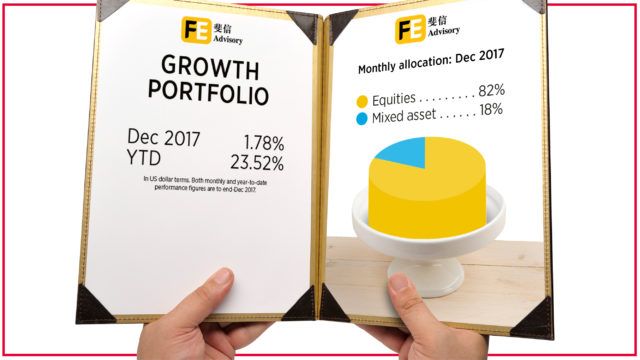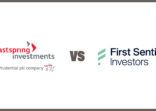Each month we feature the allocation in one of the three portfolios offered by FE Advisory Asia: cautious, balanced and growth. Data is included to show how well the portfolio has done compared to the previous month and year-to-date so that readers can get a sense of performance.
Additionally, Luke Ng, senior VP of research at FE Advisory Asia, provides a concise analysis on macro events and their potential impact on the portfolio.
A breakdown of the Growth portfolio at the end of December 2017. Performance figures are in the menu image above.

Portfolio breakdown and holdings are based on latest published data for each constituent, which may have publication dates that differ.
Percentages are based on current holdings and should only be used as a guide. Some information is provided to FE from independent third parties whom FE does not control. FE cannot guarantee the accuracy or reliability of the data, or its suitability for use by all investors.

How did the market perform in December?
Equities generally registered positive gains in December, with several markets closing the year near their all-time highs. The UK equities stood out among developed markets amid hopes for a softer Brexit. The US also saw a market rally as the long-awaited tax bill entails big cuts in corporate taxes. Backed by solid earnings and macroeconomic backdrop, investment sentiment in Japan continues to improve and the market ended higher in the month as well. In contrast, most European markets fell, mainly due to profit taking and a strong Euro rather than any material change in sentiment towards the region.
Led by the EMEA region, emerging markets had an even stronger run in December. Lowering interest rates and rising oil prices benefited Russian equities. In South Africa, Cyril Ramaphosa’s victory in the election for president of the African National Congress provided a boost in sentiment among the local markets. Emerging Asian equities also posted moderate gains in December. ASEAN equities were the front runner within the region, thanks mainly to catch-up plays following a period of underperformance against the Northern Asian equities in 2017.
Backed by solid economic backdrop, corporate bonds continued to outperform sovereign instruments. The latter were also impacted by several factors including the approval of the US tax reform bill which could drive government borrowing to higher levels, as well as comments from ECB officials that the QE program could be wound down in 2018.
How did the FE growth portfolio perform?
Our growth portfolio gained 1.78% in December in US dollar terms, outperforming the MSCI World and Bloomberg Barclays Global Aggregate Index. For the full year of 2017, the portfolio went up by 23.52%. Thanks to the decision by the OPEC and non-OPEC oil producers, including Russia, to extend output cut until the end of 2018, our holding in the energy sector grew by 5.42%. As a result it proved the best performing fund in our portfolio in December. Our performance was also boosted by higher allocation to emerging market equites, which was primarily acquired through our position in the JPMorgan Emerging Markets Equity initiated during our last rebalancing in November, as well as a China dividend-focused strategy, which has been held in the portfolio for over a year. Both funds also outperformed their respective markets during the month. On the other hand, the US small cap position we initiated in November could not quite keep pace with the market rally, despite the sector being expected to benefit from the recently approved US tax bill. Overall, all holdings in the portfolio generated positive returns in December.
FE Advisory Asia 2017 portfolio results
| Jan | Feb | Mar | Apr | May | Jun | First half of 2017 | |
| Cautious | 0.78% | 1.28% | 0.77% | 0.71% | 1.05% | 0.44% | 5.15% |
| Balanced | 2.03% | 0.78% | 0.19% | 1.23% | 1.85% | 0.44% | 6.69% |
| Growth | 2.57% | 2.00% | 0.53% | 1.19% | 2.81% | 0.17% | 9.61% |
| Jul | Aug | Sep | Oct | Nov | Dec | Full year 2017 | |
| Cautious | 0.68% | 1.16% | 0.34% | 1.64% | 0.63% | 0.48% | 10.43% |
| Balanced | 1.11% | 1.40% | 1.29% | 2.42% | 1.33% | 0.90% | 16.03% |
| Growth | 2.01% | 1.69% | 1.87% | 2.48% | 2.24% | 1.78% | 23.52% |

















